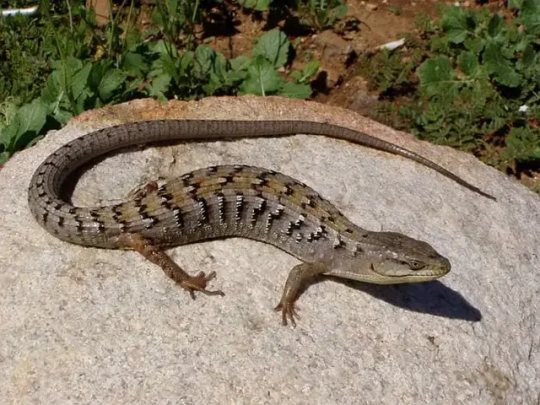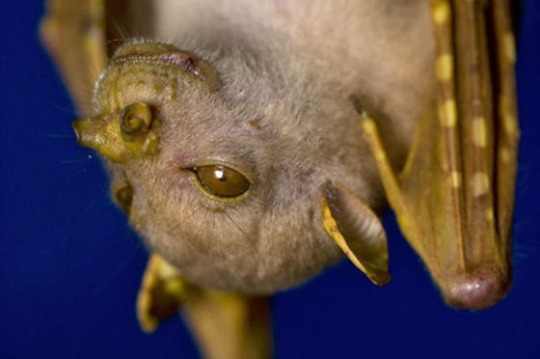Text
Uncharismatic Fact of the Day
Not all zebras have stripes! The Persian zebra, also known as the Persian onager, is actually subspecies of wild ass endemic to the arid mountains and steppes of northern Iran. There are only about 600 Persian onagers left in the wild, but several breeding programs are in place and a reintroduction in 2023 to Kavir National Park was considered highly successful.

(Image: A herd of Persian wild ass (Equus hemionus onager) by Mousa Mazinanian)
#Persian wild ass#Perissodactyla#Equidae#onagers#asses#wild asses#odd-toed ungulates#ungulates#mammals#uncharismatic facts
100 notes
·
View notes
Text
Uncharismatic Fact of the Day
Aotearoa (aka New Zealand) is home to a wonderfully diverse array of animals-- and one that mustn't be overlooked in the slightest is the slight skink! As Aotearoa's smallest skink species, they can reach a maximum length of only 5.1 cm (2 in) including the tail.

135 notes
·
View notes
Text

Red-rumped agouti (Dasyprocta leporina)
This wide-ranging mammal can be found in forests throughout northern South America including Colombia, Brazil, and Venezuela. Though smaller than its more famous relative capybara, this hefty rodent can weigh up to 13 lbs (5.9 kg). It dines on a diet of fruit, nuts, and seeds. Like a squirrel, the agouti will bury surplus food to save for a later date. But sometimes this critter forgets to come back for its stash, spreading seeds throughout its habitat as a result.
Photo: Robin Gwen Agarwal, CC BY-NC 4.0, iNaturalist
credit: American Museum of Natural History
268 notes
·
View notes
Text
Cool!
Just as a note to any aspiring biologists and/or casual biology fans: please do not be intimidated by 'professional' biologists! We are all huge nerds! I've just spent 3 days surrounded by experts in my field, and given half the opportunity they will gladly gush about their research/animals, and answer any and all questions with probably more information than you ever wanted to know. If you ever get a chance, I highly encourage you to attend conferences, seminars, or talks in your area-- your local biologist will love you, and will likely even have opportunities for you to volunteer with them if that's something you're into!
2K notes
·
View notes
Text
I can't remember if I reblogged with this addition, but either way I'm boosting again!
Just as a note to any aspiring biologists and/or casual biology fans: please do not be intimidated by 'professional' biologists! We are all huge nerds! I've just spent 3 days surrounded by experts in my field, and given half the opportunity they will gladly gush about their research/animals, and answer any and all questions with probably more information than you ever wanted to know. If you ever get a chance, I highly encourage you to attend conferences, seminars, or talks in your area-- your local biologist will love you, and will likely even have opportunities for you to volunteer with them if that's something you're into!
2K notes
·
View notes
Text
No posts this week, because I'll be presenting a talk at the Australian Society of Herpetologists Conference!
But the ask box will remain open for any suggestions or questions yall have!
77 notes
·
View notes
Text



Can You Imagine the Crab-Eating Frog?
The crab-eating frog (Fejervarya cancrivora) is a species of frog found throughout southeastern Asia, including Taiwan, southern China, the island of Sumatra, and the Philippines. They reside primarily in mangrove swamps, as well as tropical rainforests, estuaries, and near freshwater ponds and streams. They are particularly noted for their ability to tolerate high salinities, and they are the only known amphibian to make excursions into pure salt water.
The crab-eating frog is named for its usual diet which, around the mangrove, estuary, and coastal parts of its distributon, is composed mainly of crabs. This is supplemented with insects and smaller frogs, and near fresh water without crabs they make up the bulk of F. cancrivora's diet. Due to their small size, they have many predators, including birds, snakes, lizards, jungle cats, and larger fogs. Crab-eating frogs avoid being eaten by hiding in grass or under vegetation and leaf litter during the day; they are also more active at night.
Male and female crab-eating frogs are fairly similar in appearence. Both can be tan or brown, with dark mottling to resemble the muddy substrate in which they hunt, and a light underbelly. Females are slightly larger than males, reaching up to 10.7 cm (4.21 in) in length compared to only 8 cm (3.14 in). Males may also have dark throats, while females are bare.
Crab-eating frogs can breed year-round, but is particularly active during the wet season from June to October. Males will gather around bodies of water and call to attract females. Once a female has selected a mate, she will lay her eggs while he grasps her from above and fertilizes them. The eggs remain in the body of water in which they're laid without parental care. After hatching, the tadpoles take about three weeks to develop into adults.
Conservation status: F. cancrivora is considered Least Concern by the IUCN. They are harvested for food, but their primary threat comes from habitat destruction.
Photos
Nick Baker
Elijah Wostl
Benard Dupont
#crab-eating frog#Anura#Dicroglossidae#fork-tongued frogs#frogs#amphibians#marine fauna#marine amphibians#wetlands#wetland amphibians#coasts#coastal amphibians#asia#southeast asia
319 notes
·
View notes
Text
Uncharismatic Fact of the Day
Madagascar is full of unique animals, from the smallest insects all the way to the top of the food chain! Fossas occupy their own special family, Eupleridae, and feature plenty of special physical traits. One such trait is their sexual growth: from ages 1-2, female fossa undergo a process called transient masculinization, wherein they develop an enlarged clitoris resembling a penis and secrete an orange substance that colors their underside in the same pattern as the male's scrotum sac. These developments fade with age, and don't impede reproduction in any way.

(Image: A fossa (Cryptoprocta ferox) by the Chester Zoo)
150 notes
·
View notes
Text
Uncharismatic Fact of the Day
Sick of cicadas? Just call the eastern cicada-killer wasp! Female wasps specialize in hunting cicadas, using their stings to paralyze adult cicadas and dragging their victim into their nest. Later, they will lay their eggs in the bodies of the cicadas so that their young can have a tasty meal as soon as they emerge.

(Image: An eastern cicada killer wasp (Sphecius speciosus) by Dr. Joe Coehlo)
#eastern cicada-killer wasp#Hymenoptera#Bembicidae#cicada-killer wasps#apoid wasps#solitary wasps#wasps#hymenopterids#insects#arthropods#uncharismatic facts
46 notes
·
View notes
Text
Uncharismatic Fact of the Day
Why build your own nest when you can just someone else's? When it comes to laying eggs, female lace monitors seek out a large termite mound, dig a small hole, and lay their eggs inside. The termites then seal up the hole; the eggs remain protected, and the mound is kept at an ideal incubation temperature. As a bonus, the hatchlings get an all-you-can-eat termite buffet when they emerge!

(Image: A lace monitor (Varanus varius) by Richard N Horne)
321 notes
·
View notes
Note
Dude i really love your posts! Definitely very charismatic-unlike your blog's name! Are animal requests/suggestions perhaps open? I might have a bunch of ideas 😈
Thank you, i'm glad you like them! And as long as my ask box is open, im always accepting requests and suggestione!
14 notes
·
View notes
Text
Uncharismatic Fact of the Day
The black-bearded tomb bat would be right at home in an Indiana Jones movie! These bats love to roost in temples, ruins, and ancient tombs- as well as naturally formed caves. Each roost can house up to 15,000 individuals, making for a spectacularly spooky set-up for any unsuspecting adventurer.

(Image: A black-bearded tomb bat (Taphozous melanopogon) by Jenis Patel)
#black-bearded tomb bat#Chiroptera#Emballonuridae#sac-winged bats#sheath-tailed bats#bats#mammals#uncharismatic facts
159 notes
·
View notes
Text


The southern alligator lizard (Elgaria multicarinata) is a common species of lizard in the family Anguidae. The species is native to the Pacific coast of North America. It ranges from Baja California to the state of Washington and lives in a variety of habitats including grasslands, chaparral, forests, and even urban areas. In dry climates, it is likely to be found in moist areas or near streams. There are five recognized subspecies
#southern alligator lizard#Squamata#Anguidae#western alligator lizards#alligator lizards#lizards#squamates#reptiles
556 notes
·
View notes
Text
Uncharismatic Fact of the Day
When it comes to sniffing out fruit, tube-nosed fruit bats are at the top of the game! Tube-nosed bats are named for the tubes that extend from their nostrils, and each tube can be moved independently! This allows the bats to detect differences in odor concentration, a technique known as stereo olfaction.

(Image: An eastern tube-nosed fruit bat (Nyctimene robinsoni) by Piotr Naskrecki)
#tube-nosed bats#Chiroptera#Pteropodidae#yoda bats#fruit bats#old world fruit bats#bats#mammals#uncharismatic facts
148 notes
·
View notes
Text
Uncharismatic Fact of the Day
Even though Spongebob has a fun time jellyfishing, you probably wouldn't want to mess with the real thing. The famous cartoon jellyfish are based on a real species, commonly known as the mauve stinger. Just like its fictional counterpart, mauve stingers are bright pink with vivid spots-- and they have a very painful sting!

(Image: A mauve stinger (Pelagia noctiluca) by Stergios Vasilis
#mauve stinger#Semaeostomeae#Pelagiidae#jellyfish#true jellyfish#cnidarians#invertebrates#uncharismatic facts
418 notes
·
View notes
Text
Uncharismatic Fact of the Day
There are many unique forms of mating in the animal kingdom- take, for example, the bronze corydoras. When a female selects a male to mate with, she will attach her mouth to his genital opening and drink his sperm. The sperm pass through her digestive system almost entirely unharmed, and end up in a special pouch formed by her pelvic fins where they can fertilize her eggs!

(Image: A group of bronze corydoras (Corydoras aeneus) by Frank Teigler)
#bronze corydoras#Siluriformes#Callichthyidae#corydoras#armored catfish#catfish#ray-finned fish#bony fish#fish#uncharismatic facts#queer fauna
163 notes
·
View notes
Text
Uncharismatic Fact of the Day
In the world of biology, there's no greater honor than to have a species named after you. This pride month, we kick off with a tribute to two iconic LGBTQ+ rights activists: Marielle Franco and Sylvia Rivera! Franco was an outspoken advocate for queer rights in Brazil, and Rivera was at the forefront of the fight for gay and trans rights in the United States. In their honor, two newly discovered species of katydid have been named for them: Anaulacomera mariellae and Anaulacomera sylviae respectively.

(Image: Anaulacomera sylviae by Marcos Fianco)
#Anaulacomera sylviae#Anaulacomera marielle#Orthoptera#Tettigoniidae#katydids#bush crickets#insects#arthropods#uncharismatic facts
112 notes
·
View notes